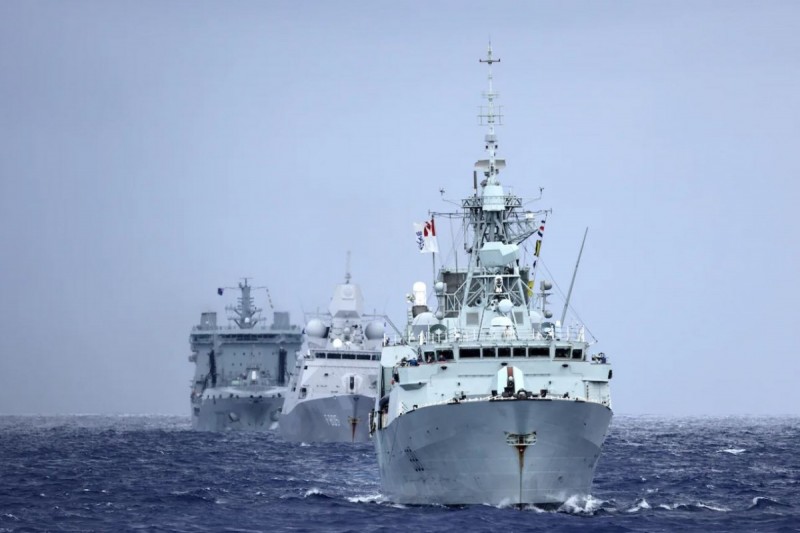Reducing conflict with China an environmental necessity

HMCS Winnipeg, along with HNLMS Evertsen and RFA Tidespring, are shown in formation in the Taiwan Strait during Exercise Pacific Crown, September 9, 2021. Photo courtesy the UK Ministry of Defence.
As the likelihood of military conflict with China grows it’s worth assessing the global balance of power. This offers an indication of which parties are likely to be the primary belligerent force in a potential future conflict.
When it comes to international bases China has only one in Djibouti, strategically located along the northeast coast of the Horn of Africa. Meanwhile, Canada’s main ally, the United States, maintains nearly 800 military bases in more than 70 countries, while the United Kingdom has dozens of international military installations.
Even the Canadian military has three times as many global bases as China. Canada currently has military installations in Kuwait, Jamaica and Senegal, and is negotiating to set up “lily pads” (also known as cooperative security locations) in Tanzania, Germany, South Korea and Singapore. On a per capita basis, Canada has over one hundred times China’s global military presence.
According to a recent investigation by The Breach, the Canadian government says its international bases are designed to “project combat power” under US leadership, while serving as “staging grounds for military operations and ‘counter-terrorism’ trainings throughout Africa, the Middle East, and the Caribbean.” The planned base in Singapore is explicitly designed to counter China, and provide a facility from which to take part in Pacific Rim military exercises with allies.
Forget Canada’s self-image as a nation of global peacekeepers.
Our new exposé, based on access-to-information documents, reveals Canada has been building a U.S-inspired network of military bases worldwide, as part of an aggressive foreign policy shift.https://t.co/sBxuYSmrzT
— The Breach (@TheBreachMedia) June 29, 2021
But it’s not just bases. Canadian Navy vessels regularly patrol the Mediterranean, the North Sea, and the Caribbean. Last month, HMCS Winnipeg joined with a US destroyer to pass through the Taiwan Strait in an exercise to “bolster [allied] presence in [the] region, fearing China’s growing military power could see vital commercial sea lanes come under Beijing’s sway.” For its part, the Chinese navy is not part of NATO or other military alliance operations and does not regularly patrol far from its shores.
In an illuminating comparison, Australian military writer Brian Toohey notes that China has four nuclear-powered, ballistic missile-armed submarines (SSBNs) that can each carry 12 missiles with a single warhead. To hit the continental US the easy-to-detect subs would have to bypass American vessels in the region. The US Navy, on the other hand, has 14 SSBNs, each containing eight independently targetable warheads, that can target any location on the globe. In other words, one US submarine can destroy 192 targets (cities) compared to 48 for all the Chinese submarines combined.
Alongside the naval presence, Canadian troops are stationed in about two dozen countries around the world, including Latvia, Ukraine and Iraq, while smaller numbers have a presence in places like the West Bank and South Korea. Unlike Canadian forces, Chinese troops are rarely deployed internationally outside UN missions.
Contrasting military spending is also revealing. As is well documented, the US spends four times more on its military than China. But even comparing Chinese and Canadian military spending illustrates something surprising. Canada spends over $30 billion a year on the Department of National Defence and Veterans Affairs while China spends around $200 billion on its military. On a per capita basis the Chinese military budget is only a third of Canada’s.
This is not a justification for increased Chinese military spending (or a defence of that country’s enlarging defense budget, which is expected to grow by more than six percent this year), but rather a plea for acknowledging the truth: humanity needs to jettison militarist nationalism.
According to the Government of Canada’s inventory of federal greenhouse gas emissions, Canada’s Navy, Army, Air Force and Special Forces (together representing the Department of National Defence) generated 543 kilotonnes of carbon dioxide emissions during 2019-20—far and away the largest polluter of any federal organization.
Graphic showing greenhouse gas emissions by federal department. Image courtesy Treasury Board Secretariat.
As I wrote in the Hamilton Spectator in August, Canada’s military is a big part of our global carbon problem:
Militarism stokes division and is intimately tied to nation-state competition, which undercuts the international co-operation required to mitigate climate chaos (not to mention the pandemic and other ecological crises). Environmentalists’ battle is not with the Russians or Chinese it’s with the polluters, which include those purportedly protecting us from the Russians and Chinese. An armada and cutting-edge fighter jets can’t stop ever more ferocious heat waves, forest fires and torrential floods.
The COVID-19 pandemic and the growing devastation wrought by climate change demonstrate a need to radically rethink popular conceptions of security. Instead of ramping up its military footprint to confront dubious threats like China, Canada ought to reduce its defence spending and international deployments. Increased provocation and belligerence only stimulates Chinese military spending, which in turn, enables domestic justifications for ever greater investments in heavy carbon emitting technologies like fighter jets and naval vessels.
Arms manufacturers and militaries around the world utilize propaganda to hype Chinese military power in order to rationalize seemingly unending expenditures on weapons of war. Consequently, this gobbles up public resources required for a just transition away from fossil fuels.
Whatever lies and exaggerations the militarists may pedal, China is not a serious contender to the US-led military order. It’s the Western-led military–industrial complex we should be most worried about—and the environmental movement needs to confront this reality head-on.
Yves Engler has been dubbed “one of the most important voices on the Canadian Left today” (Briarpatch), “in the mould of I.F. Stone” (Globe and Mail), and “part of that rare but growing group of social critics unafraid to confront Canada’s self-satisfied myths” (Quill & Quire). He has published nine books.

